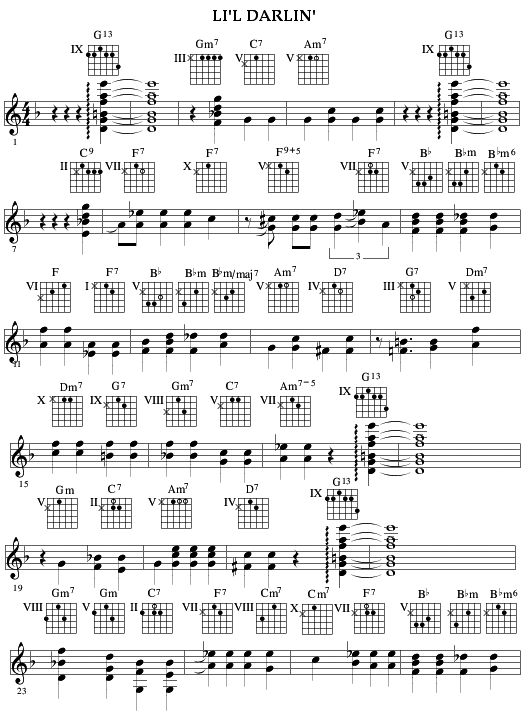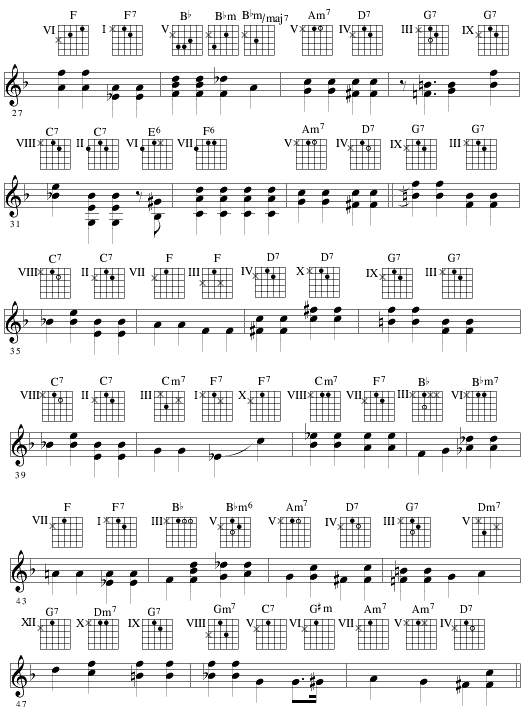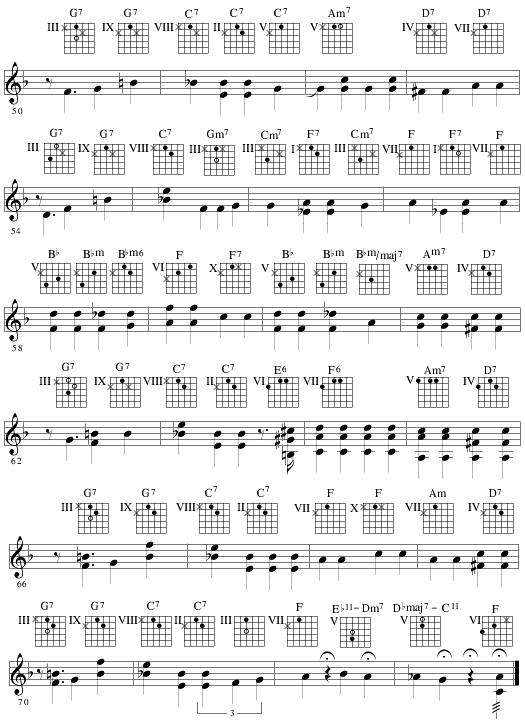Transcription: Li'l Darlin'
Composer: Neal Hefti
Transcription starts at 0'11"; ends at 4'12"
From the album: Count Basie - Wild & Swingin'
Leaders of the session: Count Basie
Recorded: July 23, 1968; Antibes Jazz Festival; Juan-les-Pins, France
CD: Fuel 2000 Records 302 061 352 2
For many Count Basie fans, " Li'l
Darlin' " is the tune most
closely associated with Freddie Green because of the guitar's G13 arpeggio
that occurs four times in the arrangement. On this CD, a microphone was
positioned very close to Freddie; his guitar was recorded much louder
than was typical. This fortunate circumstance allowed Freddie's comping
for the entire tune to be transcribed.
-
Measures 1 and 2: The celebrated
G13 voicing!
-
Measure 9: The G and C# appear to be an unusual choice
of notes, but can be heard as the 9th and augmented 5th of an F7
chord. The original
1958 Neal Hefti arrangement calls for a F7+5 in this measure.
-
Measure
11: The F voicing on beat 1 was a Freddie favorite.
-
Measures 14
and 15: Here is a perennial Freddie Green rhythm guitar "lick".
He frequently used this ascending figure when a dominant 7th
chord lasted for two measures. The written change is G7, but he
substitutes a Dm7
for the G7. Dm7, spelled d-f-a-c; sounds like a G11 or a G9sus4
when
heard over a G bass note.
-
Measures 24 and 25: Again, he substitutes
a minor seventh chord (Cm7) for a dominant seventh chord (F7).
-
Measure
32: An F6 voicing that was infrequently used by Mr. Rhythm.
-
Measure
42: The Bb voicing on beat 1 is unusual as it was fingered with
the thumb on the 6th string and the index
finger barring
the other strings.
The voicing can also be employed as a Gm7 if the
6th string bass note is sounded instead of being muted.
-
Measure 56:
The voicing on beat 1 is open to question as it cannot be discerned,
even when isolated via
a digital
transcription
device.
-
Measures 72 and 73: This descending
line is an indisputable example of Freddie's use of
one-note
voicings.
Important: The chord diagrams illustrate
probable forms used by Freddie Green based on extensive research
conducted by the primary contributors
to this web site. As there is no video record of this recording session,
Freddie's exact fingerings will never be known. Note that Freddie often
used his left thumb to mute or partially depress the 6th string.
-
An "x" indicates
that a finger is placed on the string, but the string is not fully
pushed down to make contact with the fret.
-
A "black dot" indicates
that a finger is placed on the string, and the string is pushed
down to make contact with the fret.
-
A "white dot" indicates
that a finger is placed on the string, and the string is pushed
down to make contact with the fret.
A white
dot also indicates that the note is added to the chord form on
the previous beat. Adding an upper note on beat 2 or 4 is a typical
Freddie
Green
technique.
-
If there is no "x", "black dot",
or "white dot",
the string is fully damped by a finger of the left hand.
Transcribed
by Michael Pettersen
October 2004



|

